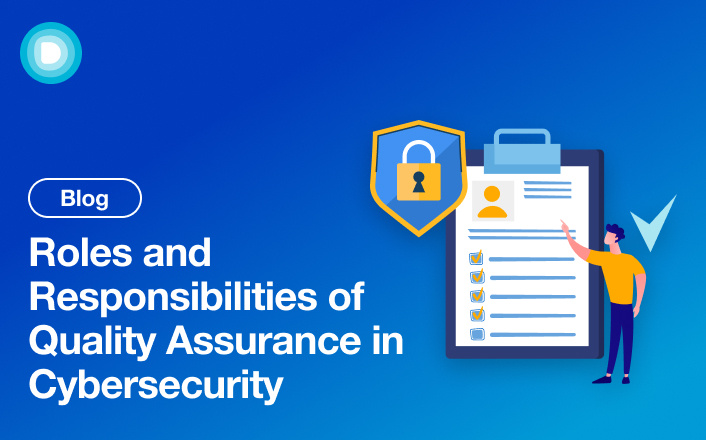- Product
-
Solution
-
By Industry
Cybersecurity solutions tailored to your industry’s needs.
-
- Resources
-
Books
Our ultimate guides and playbooks
Solution Briefs
Overview of PureDome’s functionality
-
Quizzes
Assess your cybersecurity readiness
Case Studies
PureDome customer success stories
Newsletter
Subscribe to the PureDome newsletter
-
- About Us
- Partner
- Pricing
- Download
Roles and Responsibilities of Quality Assurance in Cybersecurity
-
Aiman Ikram
-
21 May 2024
- 3 min read


Today, keeping information safe is very important. Quality Assurance (QA) helps make sure that cybersecurity measures work well and stay strong. QA teams test and check security systems to protect sensitive data from threats. In this blog, we'll look at what QA does in cybersecurity and how they help keep our digital lives secure.
Introduction to Quality Assurance in Cybersecurity
Quality Assurance (QA) in cybersecurity is the process of making sure that security systems and measures work correctly to protect information from hackers and other threats. QA teams test and check these systems regularly to find and fix any weaknesses. Their goal is to ensure that all security protocols are reliable and effective so that they can keep secure sensitive data.
Key Responsibilities of QA in Cybersecurity
Testing Security Systems
QA teams conduct thorough tests on security software and systems to ensure they function correctly and efficiently. This includes manual and automated testing methods to identify any bugs, vulnerabilities, or performance issues. They simulate cyber-attacks to see how the system responds, helping to uncover any weaknesses that hackers might exploit. Regular testing ensures that the security measures are always up-to-date and effective against the latest threats.
Ensuring Compliance
QA professionals verify that the company's cybersecurity practices comply with relevant laws, regulations, and industry standards. This includes frameworks like GDPR, HIPAA, and ISO/IEC 27001. They conduct audits and reviews to ensure that all security measures meet these requirements. Compliance not only helps avoid legal penalties but also builds trust with clients and partners by demonstrating a commitment to protecting sensitive information.
Risk Assessment
QA teams perform detailed risk assessments to identify potential security threats and vulnerabilities within the organization’s systems. They evaluate the likelihood and impact of different risks. In this way they provide a clear understanding of the company’s security posture. Based on this assessment, they recommend mitigation strategies to reduce the identified risks. This proactive approach helps prevent security incidents before they occur, safeguarding the company’s assets.
Continuous Monitoring
QA professionals are responsible for the ongoing monitoring of security systems to detect and respond to security incidents in real-time. They use various tools and technologies to track network activity, looking for signs of unusual or suspicious behavior that could indicate a breach. By maintaining constant vigilance, they can quickly address potential threats, minimizing damage and ensuring swift recovery.
Improving Security Protocols
Based on the insights gained from testing, compliance checks, and continuous monitoring, QA teams regularly recommend and implement improvements to the organization's security protocols. They work closely with other departments, such as IT and development, to update security policies, procedures, and technologies. This continuous improvement process helps the organization stay ahead of emerging threats and ensures that security measures evolve to meet new challenges.
How to Implement Cybersecurity in QA
Incorporate Security Testing in QA Processes
Integrate security tests into the QA processes from the start of development. This includes checking code for vulnerabilities and running simulated cyber-attacks to see how the system responds. Adding these tests to the continuous integration/continuous deployment (CI/CD) pipeline helps catch and fix security issues early.
Use Secure Coding Practices
Train QA and development teams to follow secure coding practices, such as validating inputs, handling errors properly, and avoiding hard-coded passwords. Regular code reviews and pair programming can help ensure these practices are consistently applied, reducing the risk of security flaws in the code.
Perform Regular Security Audits
Conduct regular security audits to review and assess the effectiveness of security measures. This involves checking compliance with security policies, evaluating the security of infrastructure, and making sure all security patches and updates are applied on time.
Implement Zero Trust Network Access (ZTNA)
Apply PureDome’s Zero Trust Network Access (ZTNA) model to enhance security. ZTNA ensures that every user and device must be verified before accessing resources, even if they are inside the network. This approach reduces the risk of unauthorized access.

Educate and Train QA Teams on Cybersecurity
Provide ongoing education and training for QA teams about the latest cybersecurity threats, trends, and best practices. Encourage a culture of security awareness where team members are vigilant and proactive about potential security issues.
The Future of QA in Cybersecurity
The future of QA in cybersecurity looks promising and vital. They will use the latest technologies, like artificial intelligence (AI) and machine learning (ML), to find and fix security issues faster. Continuous testing and real-time monitoring will become standard to quickly spot and address new threats.
QA professionals will also work more closely with other teams to ensure security is built into every part of the development process. Training and education will remain important to keep QA teams updated on the latest threats and best practices.
Conclusion
In conclusion, QA is crucial in cybersecurity. It ensures systems are secure through testing, compliance, risk assessment, monitoring, and improvement. As technology advances, QA will continue evolving to meet new challenges and threats.
Frequently Asked Questions
Why is QA important in cybersecurity?
QA ensures that security measures work effectively, protecting against cyber threats.
What are the key responsibilities of QA in cybersecurity?
Testing, compliance, risk assessment, monitoring, and improving security protocols.
How does the future of QA in cybersecurity look?
It's promising, with advancements in technology and ongoing training to address evolving threats.